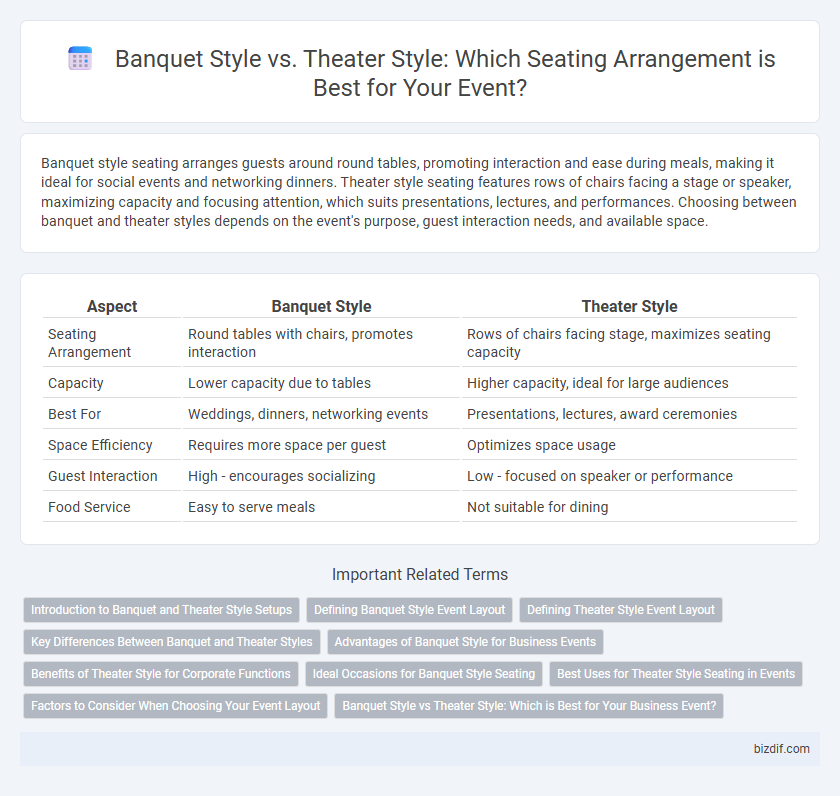Banquet style seating arranges guests around round tables, promoting interaction and ease during meals, making it ideal for social events and networking dinners. Theater style seating features rows of chairs facing a stage or speaker, maximizing capacity and focusing attention, which suits presentations, lectures, and performances. Choosing between banquet and theater styles depends on the event's purpose, guest interaction needs, and available space.
Table of Comparison
| Aspect | Banquet Style | Theater Style |
|---|---|---|
| Seating Arrangement | Round tables with chairs, promotes interaction | Rows of chairs facing stage, maximizes seating capacity |
| Capacity | Lower capacity due to tables | Higher capacity, ideal for large audiences |
| Best For | Weddings, dinners, networking events | Presentations, lectures, award ceremonies |
| Space Efficiency | Requires more space per guest | Optimizes space usage |
| Guest Interaction | High - encourages socializing | Low - focused on speaker or performance |
| Food Service | Easy to serve meals | Not suitable for dining |
Introduction to Banquet and Theater Style Setups
Banquet style setups feature round tables designed for dining and social interaction, accommodating group conversations and meal service efficiently. Theater style arrangements consist of rows of chairs facing a stage or focal point, maximizing seating capacity for presentations or lectures. Choosing between banquet and theater styles depends on the event's objective, space, and guest experience requirements.
Defining Banquet Style Event Layout
Banquet style event layout features round or rectangular tables arranged to facilitate dining, encouraging social interaction and easy movement among guests. This setup supports meals, presentations, and discussions, often accommodating 8 to 12 people per table to foster engagement. The design prioritizes comfort and accessibility, making it ideal for weddings, galas, and corporate dinners.
Defining Theater Style Event Layout
Theater style event layout arranges rows of chairs facing a single focal point such as a stage or screen, optimizing seating capacity for presentations or performances. This layout eliminates tables, allowing for maximum audience accommodation in limited spaces and enhancing visual engagement. Ideal for conferences, seminars, and keynote sessions, theater style prioritizes clear sightlines and streamlined attendee movement.
Key Differences Between Banquet and Theater Styles
Banquet style features round tables promoting interaction and dining opportunities, ideal for meals and socializing during events. Theater style arranges chairs in rows facing the stage, maximizing seating capacity and optimizing audience focus for presentations or performances. Key differences include seating layout, guest engagement, and suitability for event types emphasizing either group interaction or audience attentiveness.
Advantages of Banquet Style for Business Events
Banquet style seating fosters direct interaction and networking opportunities, making it ideal for business events that emphasize collaboration and relationship building. This arrangement enhances comfort and accessibility, allowing attendees to easily engage in group discussions and enjoy meals simultaneously. The structured setup supports formal presentations while maintaining an inviting atmosphere conducive to productive business exchanges.
Benefits of Theater Style for Corporate Functions
Theater style seating optimizes space utilization, accommodating a larger audience in a limited area, which is ideal for corporate presentations and keynote speeches. This arrangement enhances visibility and focus by directing all attendees' attention toward the stage or speaker, promoting engagement and effective communication. Its streamlined setup facilitates easy movement and quick transitions between sessions, making it highly efficient for corporate functions requiring a formal and professional environment.
Ideal Occasions for Banquet Style Seating
Banquet style seating is ideal for events that encourage social interaction and dining, such as weddings, gala dinners, and award ceremonies, where guests benefit from round tables that facilitate conversation. Corporate dinners and fundraising events also suit this arrangement, providing an elegant setting for networking and formal meals. This layout supports service efficiency and creates an intimate atmosphere, enhancing guest experience during celebratory and formal occasions.
Best Uses for Theater Style Seating in Events
Theater style seating is best suited for events focused on presentations, lectures, or performances where maximum audience capacity and clear sightlines are essential. This layout optimizes space by aligning chairs in rows facing a stage or speaker, making it ideal for conferences, seminars, and award ceremonies. It enhances audience engagement by minimizing distractions and ensuring every seat has a clear view of the event focal point.
Factors to Consider When Choosing Your Event Layout
Banquet style seating promotes interaction and networking, making it ideal for events centered around dining and group discussions, while theater style maximizes seating capacity and focuses attention toward a stage or presentation. Factors to consider when choosing between these layouts include the event's purpose, expected guest count, space dimensions, and the need for audiovisual equipment or movement flow. Assessing these elements ensures the layout supports both comfort and event objectives, enhancing guest experience and operational efficiency.
Banquet Style vs Theater Style: Which is Best for Your Business Event?
Banquet style seating, featuring round tables that facilitate interaction and dining, is ideal for business events focused on networking and collaboration, while theater style seating arranges chairs in rows for maximum audience capacity, perfect for presentations and lectures. Choosing banquet style promotes engagement and comfort during meals or group discussions, whereas theater style optimizes space efficiency when the primary goal is information delivery to a large audience. Understanding your event objectives and attendee needs ensures the best seating arrangement to enhance participation and overall experience.
Banquet style vs Theater style Infographic

 bizdif.com
bizdif.com